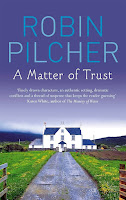 |
| (Amazon UK link) |
Claire is the main protagonist of this book, which mostly takes place in 2006. However there are some chapters set in the past - organised a little confusingly from a chronological perspective, but extremely well from the point of view of telling the story. The novel opens in 1988 when Claire, who has just finished school and must be 18, goes to see her best friend Jonas. She has been in love with him for years, and is pretty sure he feels the same way. Tonight, she is sure, is the time is right for a declaration.
But she’s in for a painful shock. Jonas doesn’t greet her with his usual welcome, or ask for her help on the car he’s repairing. He won’t look her in the eye, and tells her they can’t be friends any longer. There are no explanations, and Claire is broken hearted.
We then whizz forward to 2005. Claire is happily married to Art, and they run a very successful restaurant together in New York. She takes a few minutes to chat on the phone to her stepfather Leo, in Scotland; she’s clearly very fond of him, and chats to him regularly. The action then moves back to 1980; Clare is nine, and lives with her widowed mother, when Leo comes into their lives…
Leo has two children himself, Marcus and Charity, who have no wish for a stepmother or step-sister, and take an unaccountable dislike to both. We see incidents over the years when they - particularly the ironically named Charity - behave very nastily to Claire. They're both immature and selfish; it's hard to see how such a kind, gentle person as Leo could have produced such nasty offspring. But Claire has her close friendship with Jonas, and goes to a local school, so mostly their paths don’t cross.
The story really gets going when Claire has a phone call letting her know that Leo has had a bad fall, and has been in hospital. Worse, she learns that he’s showing early signs of dementia. And apparently Jonas is spending a lot of time with him, including dealing with all his paperwork. Claire flies back to spend some time with him and is sad that her step-siblings seem to have no interest in spending time with their father.
It’s quite a complex set of storylines, but Robin Pilcher has such a gift of characterisation (like his late mother did) that I had no trouble remembering who was whom, and how they related to each other. I found the book compulsive reading - I was drawn into the family, particularly fond of Claire and Art, who is clearly a thoughtful and generous man.
In the twelve years since I first read this book I had entirely forgotten the plot: I had no idea why Jonas threw Claire out of his life so suddenly and brutally, and was shocked when the truth was finally revealed. I assumed they would become friends again, but hoped they weren’t going to rekindle their teenage romance since both Art and Jonas’s wife Liv are likeable, kind people and I didn’t want to see them hurt. I also hoped that Leo wasn’t going to die suddenly…
One of the subplots - which becomes quite major - involves different characters making plans for the large home (and land) where Leo lives. As it becomes clear that he can’t live there alone much longer, Art comes up with the idea of building a conference centre there. But Marcus and Charity have other plans, and Jonas appears to too, although he’s clearly uncovered something dodgy in Leo’s financial papers.
I read the book in just a couple of days, and thoroughly enjoyed it. I would recommend it highly to anyone who likes women’s fiction or who is a fan of the author’s mother’s work.
No comments:
Post a Comment